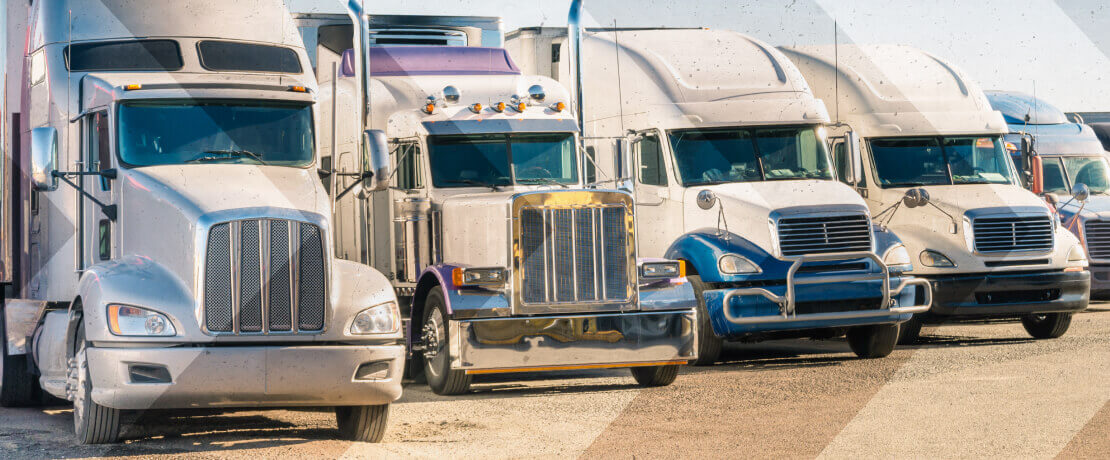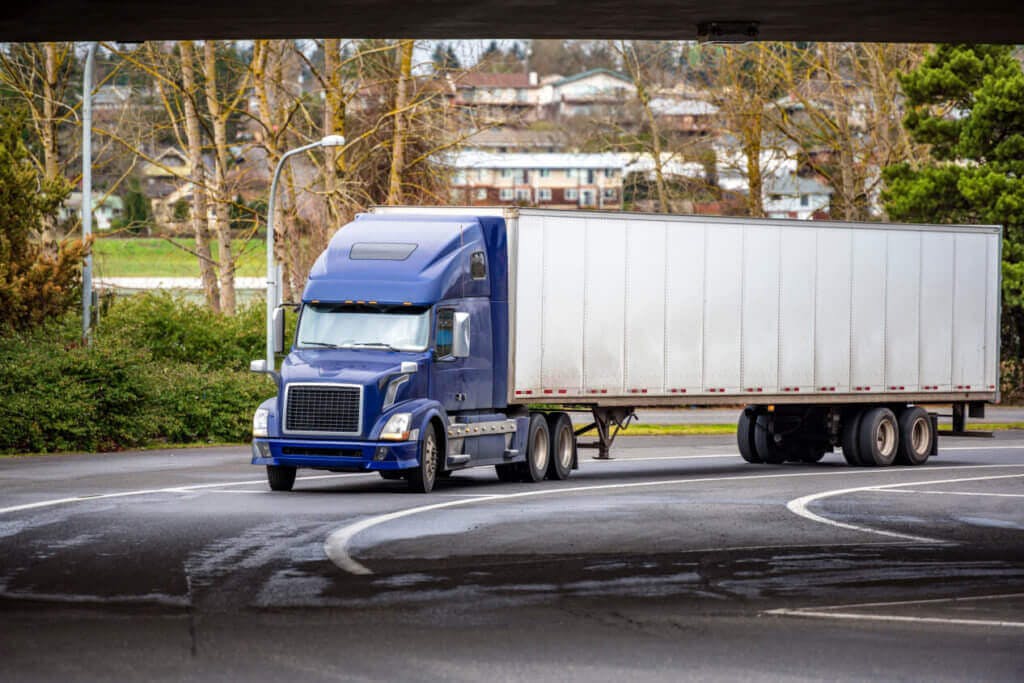Flatbed vs Dry Van: Which is Right for Your Business?

Find your next load
Make more money starting now.
When it comes to your freight shipping needs, there are a lot of choices out there. But for those in the transportation industry, it often comes down to which trailer is the best for the job. Dry vans and flatbed trailers are the two most common. But when it comes to dry van vs. flatbed, what is the right choice for your business? It’s important to understand both before you can make that call.
Flatbed vs. dry van: Key differences
When it comes to flatbed vs. dry van trailers, you need to consider the dimensions, weight capacity, how each trailer is loaded, and what it can carry. The right one for you depends on what you plan to haul.
Dry van dimensions and specs
Dry vans come in a few standard configurations, but the most common is 53 feet long, 13′ 6” high (exterior), and 102” wide. Some variations, including 48-foot trailers and smaller 28-foot trailers, are often used in tandem so that you can pull two or three trailers at one time.
They can also have either air glide or spring suspension systems. The dry van you choose will depend on what you most commonly haul, how far you carry it, at what rate, and even things like the typical local weather and the type of docks you encounter at loading and unloading locations.
You can also get custom dry vans for particular needs.
Weight capacity
The standard weight capacity for a dry van is 45,000 pounds maximum and lower for shorter dry vans. How much you can safely carry depends on the suspension configuration and trailer structure. A 53-foot trailer has up to 26 pallet locations.

Dry van types
Dry vans come in various construction types depending on the floor type, the sides, and the overhead construction. Common examples include:
- Sheet and post dry vans
- Plate dry vans
- Custom spec dry vans
Dry vans also have different loading mechanisms to work with different types of loading docks. Fleet managers will need to consider the types of docks used as well.
Flatbed dimensions and specs
Flatbeds are a little shorter than typical dry vans at 48 feet. Flatbeds also vary by dimension, and legal requirements vary for hauling different loads. If you are carrying something taller than 10 feet, you will need a flatbed with a double drop for clearance. If you are moving something especially long, extendable flatbeds can reach up to 80 feet in length.
Specialty flatbeds to haul oversized loads will vary in length and size depending on the cargo.
Weight capacity
A flatbed trailer’s standard weight capacity is 48,000 pounds, whether it’s a single- or double-drop trailer or a standard-size flatbed. Anything that exceeds this capacity is considered a large load or heavy load and often requires special permitting.
Flatbed types
Flatbeds also come in a variety of types. Most are standard-height flatbeds, 58”, which matches up with most loading docks. Specialty types include the step-deck or single-drop trailer, which has a single step and a low deck height for shipping items, either 8′ 6” or 10 feet tall, depending on the amount of drop.
The double-drop trailer, or lowboy, also has a low deck design that allows you to carry taller freight legally. If you have cargo taller than the 10-foot restriction, you need special permitting for a tall or oversized load.
Removable gooseneck trailers often carry motorized equipment. These are usually either step-deck or lowboy trailers. But you can remove the gooseneck, giving you a ramp to drive a vehicle onto the trailer.
Up to 80 feet long, stretched flatbed trailers can carry exceptionally long loads and usually require special permitting.
Finally, the Conestoga trailer is for heavy cargo like steel, lumber, wiring, machinery, and aircraft parts. You still load it like a regular flatbed, from the sides, rear, or top. But it has a sliding tarp system that encloses and protects cargo during transit.
Dry van vs. flatbed: Advantages and challenges
When talking about flatbed trailers vs. dry van trailers, it’s good to look at the pros and cons from both carriers’ and shippers’ perspectives.
Dry van advantages
Dry vans are the most common type of trailer by far, and for good reason. They are very versatile and have multiple advantages for both carriers and shippers.
Carriers:
- Securing cargo is much simpler with an enclosed trailer dry van.
- Hook and drop options (where you drop a full trailer and hook up another one without waiting for the other to unload) can speed up turnaround time.
- The loading and unloading process is simple, as the truck height and dock height are usually the same.
- It’s an affordable way to ship, so dry vans are always in high demand.
Shippers:
- Cargo is protected inside the dry van, minimizing the likelihood of damage or theft.
- Dry vans are suitable for shipping a variety of cargos, so you can consolidate shipments and save money.
- You don’t need a loading dock. If you have a forklift, you can unload cargo from the semi truck’s rear.
Dry van challenges
As with any shipping method, there are drawbacks to a dry van, and it’s helpful to know them upfront.
Carriers:
- You can only load or unload the trailer from the rear.
- They do not offer temperature control.
- Floors, usually made of wood, are more susceptible to damage.
Shippers:
- You need separate trailers for refrigerated or temperature-controlled goods.
- Because dry vans are affordable and in high demand, you need to use load boards, brokers, or other methods to ensure you can schedule transport on time.

Flatbed advantages
Like their dry van counterparts, flatbeds have pros and cons for both carriers and shippers.
Carriers:
- Flatbed drivers generally make more than dry van drivers.
- You don’t have to back up to docks or wait for an empty dock to load or unload.
- Due to the high demand for flatbeds, plenty of work is always available.
- Flatbeds have larger cargo space, maximum capacity, and higher weight limits because they are open to the top and side.
Shippers:
- Flatbeds can haul oversized cargo and specialty loads you can’t fit in a dry van.
- Loading and unloading are more manageable because you can access freight from the front, rear, side, or top.
Flatbed challenges
Carriers:
- With additional pay comes additional responsibility and vigilance.
- It’s essential to pack correctly to prevent potentially high-liability accidents.
- Flatbeds require specialized driving and hauling skills.
Shippers:
- Cargo is exposed to the elements during transit — no concealed containers.
- You may need special equipment or trained personnel to load and unload cargo.
- Flatbed shipping is generally more expensive than standard shipping.
Dry van or flatbed: Which is right for your business?
The answer depends a lot on you and what you want from your trucking business. Both dry vans and flatbeds are in high demand, so there is plenty of work for both kinds of drivers. A flatbed driver needs more loading and driving expertise, but generally, they make more money. Look at what type of work you want to do, the loads you enjoy hauling, and the demand and pay in your area.
Use load boards to find dry van and flatbed freight.
Once you decide what kind of trucking is right for you, use the Truckstop load board to find dry van and flatbed loads. You can compare rates, align lanes with your current business, reduce deadhead time, and stay loaded. Get started today.
Topics:
Get helpful content delivered to your inbox.
Sign up today.
Find high-quality loads fast, get higher rates on every haul, and access tools that make your job easier at every turn.






